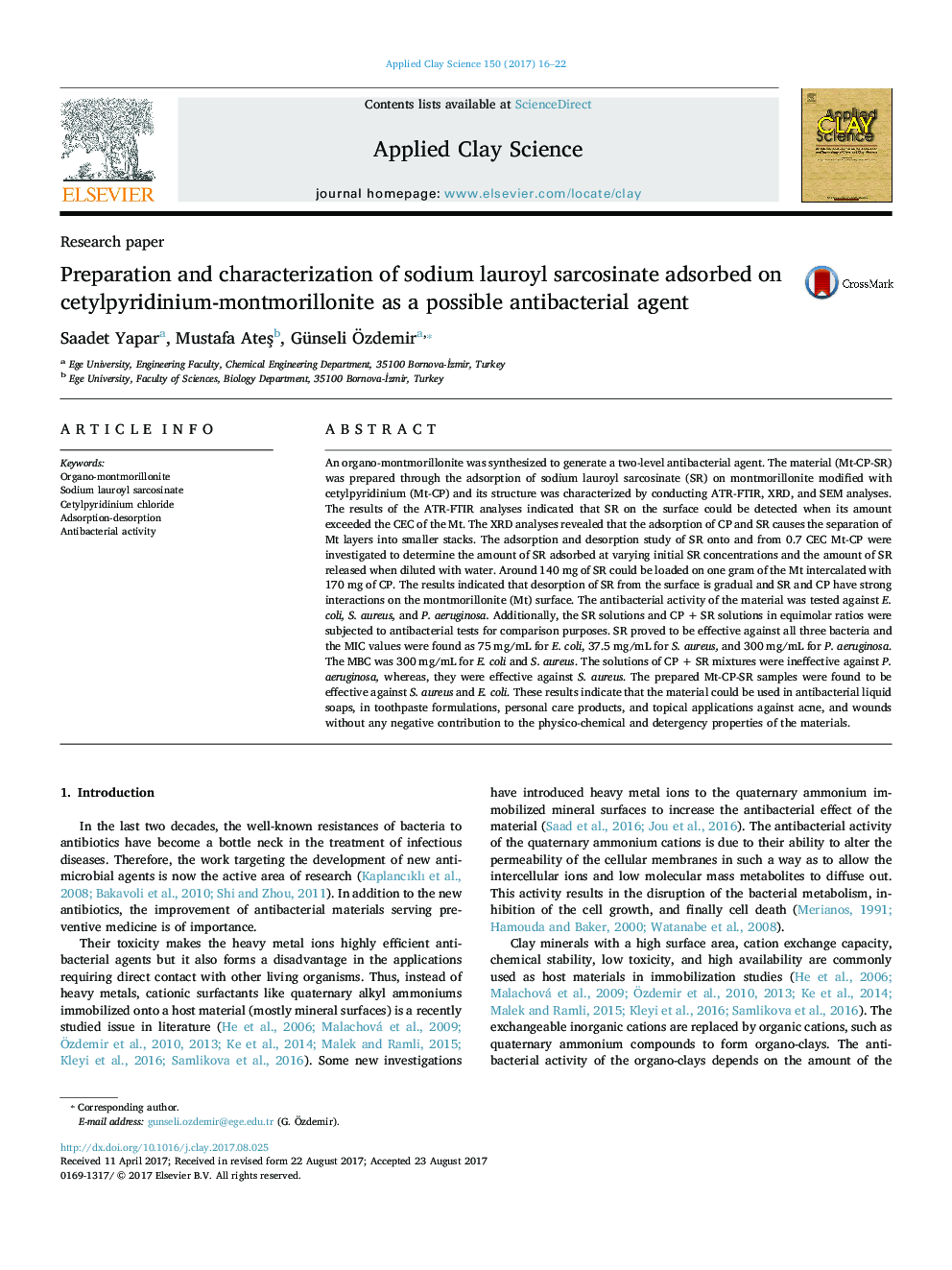| کد مقاله | کد نشریه | سال انتشار | مقاله انگلیسی | نسخه تمام متن |
|---|---|---|---|---|
| 5468478 | 1519038 | 2017 | 7 صفحه PDF | دانلود رایگان |
عنوان انگلیسی مقاله ISI
Preparation and characterization of sodium lauroyl sarcosinate adsorbed on cetylpyridinium-montmorillonite as a possible antibacterial agent
ترجمه فارسی عنوان
آماده سازی و مشخص کردن سدیم لوروئیل سارکوزینات جذب شده بر روی اتلیپیریدینیم-مونتموریلونیت به عنوان یک عامل ضد باکتری امکان پذیر است
دانلود مقاله + سفارش ترجمه
دانلود مقاله ISI انگلیسی
رایگان برای ایرانیان
کلمات کلیدی
موضوعات مرتبط
مهندسی و علوم پایه
علوم زمین و سیارات
ژئوشیمی و پترولوژی
چکیده انگلیسی
An organo-montmorillonite was synthesized to generate a two-level antibacterial agent. The material (Mt-CP-SR) was prepared through the adsorption of sodium lauroyl sarcosinate (SR) on montmorillonite modified with cetylpyridinium (Mt-CP) and its structure was characterized by conducting ATR-FTIR, XRD, and SEM analyses. The results of the ATR-FTIR analyses indicated that SR on the surface could be detected when its amount exceeded the CEC of the Mt. The XRD analyses revealed that the adsorption of CP and SR causes the separation of Mt layers into smaller stacks. The adsorption and desorption study of SR onto and from 0.7 CEC Mt-CP were investigated to determine the amount of SR adsorbed at varying initial SR concentrations and the amount of SR released when diluted with water. Around 140Â mg of SR could be loaded on one gram of the Mt intercalated with 170Â mg of CP. The results indicated that desorption of SR from the surface is gradual and SR and CP have strong interactions on the montmorillonite (Mt) surface. The antibacterial activity of the material was tested against E. coli, S. aureus, and P. aeruginosa. Additionally, the SR solutions and CPÂ +Â SR solutions in equimolar ratios were subjected to antibacterial tests for comparison purposes. SR proved to be effective against all three bacteria and the MIC values were found as 75Â mg/mL for E. coli, 37.5Â mg/mL for S. aureus, and 300Â mg/mL for P. aeruginosa. The MBC was 300Â mg/mL for E. coli and S. aureus. The solutions of CPÂ +Â SR mixtures were ineffective against P. aeruginosa, whereas, they were effective against S. aureus. The prepared Mt-CP-SR samples were found to be effective against S. aureus and E. coli. These results indicate that the material could be used in antibacterial liquid soaps, in toothpaste formulations, personal care products, and topical applications against acne, and wounds without any negative contribution to the physico-chemical and detergency properties of the materials.
ناشر
Database: Elsevier - ScienceDirect (ساینس دایرکت)
Journal: Applied Clay Science - Volume 150, 15 December 2017, Pages 16-22
Journal: Applied Clay Science - Volume 150, 15 December 2017, Pages 16-22
نویسندگان
Saadet Yapar, Mustafa AteÅ, Günseli Ãzdemir,
